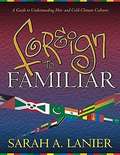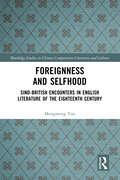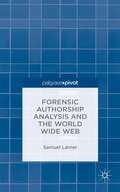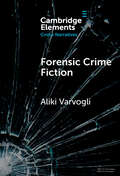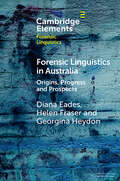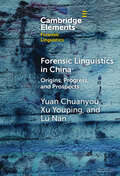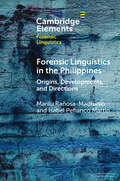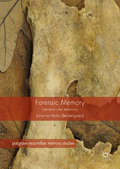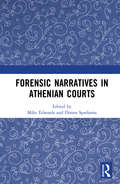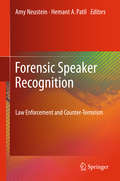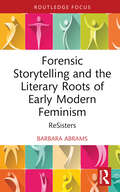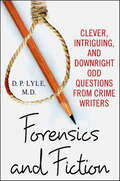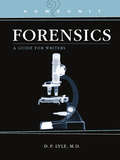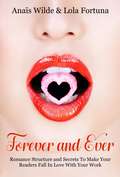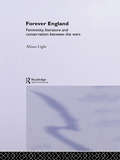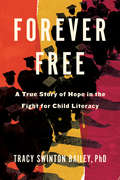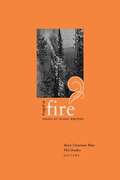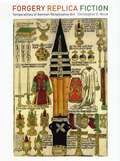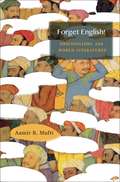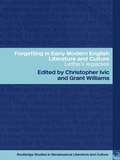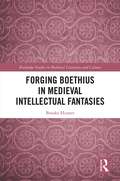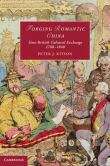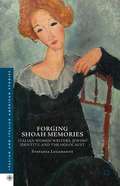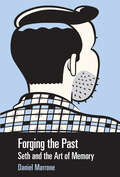- Table View
- List View
Foreign to Familiar: A Guide to Understanding Hot- and Cold-Climate Cultures
by Sarah A. LanierThe book divides the world into two halves: hot-climate cultures and cold-climate cultures and intends to be helpful to those who wish to cross the culture gap.
Foreignness and Selfhood: Sino-British Encounters in English Literature of the Eighteenth Century (Routledge Studies in Chinese Comparative Literature and Culture)
by Mengmeng YanIn inviting a rethinking of ideas of foreignness and selfhood, this book explores Sino-British encounters in eighteenth-century English literature, providing detailed critical and literary analysis of individual texts pertaining to China from this period. The author provides a synthesis of approaches to China in eighteenth-century English literature, involving fictional writing related to China, adaptations of Chinese source texts, and translations of Chinese literary works. By discussing various writings about tea and tea-drinking, Arthur Murphy’s The Orphan of China (1759), Oliver Goldsmith’s The Citizen of the World (1760–62), and Thomas Percy’s Hau Kiou Choaan (1761), she highlights the significance of reading these texts not simply as documents of a historical kind, but as texts that are worthy of literary and artistic attention on the basis of their rich variety in genre, style, and themes. The author proposes that Chinese and British cultures are not antithetical entities: they exist in relation to one another and create possibilities in the continuing appreciation of diversity amidst a drive to universality. This study will be primarily helpful to university students and professors of English literature, comparative literature, and history worldwide.
Forensic Authorship Analysis and the World Wide Web
by Samuel LarnerImplementing a novel method for identifying idiolectal co-selections and taking the UNABOM investigation as a case study, this book evaluates the effectiveness and reliability of using the web for forensic purposes, since forensic linguists often use the web as a tool in forensic authorship analysis cases. A notable example includes the American trial of the Unabomber, in which the web was searched for idiolectal co-selections, and claims made about their distinctiveness based on the number of search results. In order to assess whether the web can reliably be used in this way, two experiments are described in which the web is used to attribute documents to their authors, both when texts produced by candidate authors are, and are not, available for comparison. With considerable unreliability in the results- both between different search engines and over time - this book argues that more caution is required in using the web as a corpus for forensic purposes.
Forensic Crime Fiction (Elements in Crime Narratives)
by Aliki VarvogliThis study of forensic crime fiction from the US and the UK examines the prominent roles that women play in many of these novels, arguing that there are historical continuities with earlier forms of contact with the dead body. Refuting claims that the female forensic examiner exhibits traits of typically masculine behaviour, it suggests that the female gaze humanises the victims of crime and alters their representations. Utilising the views of a world-famous forensic scientist interviewed for this Element, this study also explores the role and treatment of science in forensic crime fiction, shedding light on an area of the genre. Finally, there is a consideration of killers in forensic crime novels, proposing that the relationship between killer and investigator is different from that of the classic crime novel. There are also two Appendices containing interviews with Professor Niamh Nic Daeid and with Val McDermid.
Forensic Linguistics in Australia: Origins, Progress and Prospects (Elements in Forensic Linguistics)
by Diana Eades Helen Fraser Georgina HeydonThis Element presents an account of forensic linguistics in Australia since the first expert linguistic evidence in 1959, through early work in the 1970s-1980s, the defining of the discipline in the 1990s, and into the current era. It starts with a consideration of some widespread misconceptions about language that affect the field and some problematic ideologies in the law, which underly much of the discussion throughout the Element. The authors' report of forensic linguists' work is structured in terms of the linguistic, interactional and sociocultural contexts of the language data being analysed, whether in expert evidence, in research, or in practical applications of linguistics in a range of legal settings. The Element concludes by highlighting mutual engagement between forensic linguistic practitioners and both the judiciary and legal scholars, and outlines some of the key factors which support a critical forensic linguistics approach in much of the work in the authors' country.
Forensic Linguistics in China: Origins, Progress, and Prospects (Elements in Forensic Linguistics)
by Yuan Chuanyou Xu Youping Lu NanThis Element offers a comprehensive examination of forensic linguistics in China. It traces the origins of the field in the 1980s and 1990s, and highlights the progress made in the 2000s, with a focus on the work of influential scholars such as Pan Qingyun, Wang Jie, Du Jinbang, Liao Meizhen, Yuan Chuanyou, and Wang Zhenhua. It discusses the development of Discourse Information Theory, the Principle of Goal, Functional Forensic Discourse Analysis, and Legal Discourse as a Social Process. It also analyses studies on language evidence and explores legal translation. It discusses emerging research areas, including cyberbullying language research, internet court discourse analysis, authorship analysis, expert assistance systems, and speaker identification and evidence of forensic phonetics. This Element provides valuable insights into the growth and potential of forensic linguistics in China, serving as a comprehensive resource for scholars, researchers, and practitioners interested in the intersection of language and law.
Forensic Linguistics in the Philippines: Origins, Developments, and Directions (Elements in Forensic Linguistics)
by Isabel Pefianco Martin Marilu Rañosa-MadrunioThis Element offers a critical review of forensic linguistic studies in the Philippines. The studies within, collected over a period of eight to nine years, reveal relevant themes from texts in courtroom proceedings, legal writings, and police investigations. The studies also delve into issues of language choice and language policy. The Element begins with a description of language policy in the Philippines, focusing specifically on language in the legal domain. The main body of the Element is the critical review of Philippine forensic linguistics studies. This critical review takes a sociolinguistic stance, in that issues of language and law are discussed from the lens of social meanings and social practice. From this critical review of forensic linguistics studies, the authors hope to chart future directions for forensic linguistic studies and research in the Philippines.
Forensic Memory
by Johanne Helbo BøndergaardThis book describes and analyses a particular literary mode that challenges the aesthetics of testimony by approaching the past through detection, analysis, and ‘archaeological’ digging. How does forensic literature narrate the past in terms of plot, language, narration, and use of visual media? This volume examines how forensic literature provides an important corrective to the forensic paradigm and a means of exploring the relationship between visual and material evidence and various forms of testimony. This literary engagement with the past is investigated in order to challenge a forensic paradigm that aims to eliminate the problems related to human testimony through scientific objectivity, resulting in a fresh and original text in which Bøndergaard argues literature’s potential to explore the mechanisms of representation, interpretation, and narration.
Forensic Narratives in Athenian Courts
by Mike Edwards Dimos SpatharasForensic Narratives in Athenian Courts breaks new ground by exploring different aspects of forensic storytelling in Athenian legal speeches and the ways in which forensic narratives reflect normative concerns and legal issues. The chapters, written by distinguished experts in Athenian oratory and society, explore the importance of narratives for the arguments of relatively underdiscussed orators such as Isaeus and Apollodorus. They employ new methods to investigate issues such as speeches’ deceptiveness or the appraisals which constitute the emotion scripts that speakers put together. This volume not only addresses a gap in the field of Athenian oratory, but also encourages comparative approaches to forensic narratives and fiction, and fresh investigations of the implications of forensic storytelling for other literary genres. Forensic Narratives in Athenian Courts will be an invaluable resource to students and researchers of Athenian oratory and their legal system, as well as those working on Greek society and literature more broadly.
Forensic Speaker Recognition
by Amy Neustein Hemant A. PatilForensic Speaker Recognition: Law Enforcement and Counter-Terrorism is an anthology of the research findings of 35 speaker recognition experts from around the world. The volume provides a multidimensional view of the complex science involved in determining whether a suspect's voice truly matches forensic speech samples, collected by law enforcement and counter-terrorism agencies, that are associated with the commission of a terrorist act or other crimes. While addressing such topics as the challenges of forensic case work, handling speech signal degradation, analyzing features of speaker recognition to optimize voice verification system performance, and designing voice applications that meet the practical needs of law enforcement and counter-terrorism agencies, this material all sounds a common theme: how the rigors of forensic utility are demanding new levels of excellence in all aspects of speaker recognition. The contributors are among the most eminent scientists in speech engineering and signal processing; and their work represents such diverse countries as Switzerland, Sweden, Italy, France, Japan, India and the United States. Forensic Speaker Recognition is a useful book for forensic speech scientists, speech signal processing experts, speech system developers, criminal prosecutors and counter-terrorism intelligence officers and agents.
Forensic Storytelling and the Literary Roots of Early Modern Feminism: ReSisters (Routledge Focus on Literature)
by Barbara AbramsThe writing of letters and the rise of the novel provided a way for some women to express themselves at a time when the all-male French Academy defined the very parameters of French literary acceptability and tradition. Women who were consigned to convents, workhouses or prisons were in most respects deprived of agency, yet many found ways to respond to the legal documents served against them. The letters and associated materials preserved in their legal files provide evidence that these women did not remain quiet, as they found means to resist authority. The forensic storytelling examined in this book supports the conclusion that the documents written in these constrained circumstances have both historical and literary merit and form the core of an understudied genre of literature.
Forensics and Fiction: Clever, Intriguing, and Downright Odd Questions from Crime Writers
by D. P. Lyle“Indispensable . . . Don’t even think of writing a medical mystery without the wise counsel of Dr. D. P. Lyle.” —Lee Goldberg, #1 New York Times–bestselling author of the Diagnosis Murder and Monk novelsHow long can someone survive in a cold, damp cave without food or water? How was diphtheria treated in 1886? Can Botox kill? Can DNA be found on a knife years later? How are mummified corpses identified? How long does it take blood to clot when spilled on a tile floor? What happens in death from electrocution?As a consultant to many novelists around the world and to the writers of such popular TV shows as Monk, Law & Order, House, and CSI: Miami, D. P. Lyle, M.D., has answered many cool, clever, and oddball questions over the years. Forensics and Fiction: Clever, Intriguing, and Downright Odd Questions from Crime Writers is a collection of the best of these questions. The answers are provided in a concise and entertaining fashion that will keep you wide awake so you can read “just one more.”“A terrific resource for crime writers and anyone interested in forensics . . . will jump-start your imagination about all kinds of ingenious crimes, crime-solving techniques, and plot twists.” —Matt Witten, supervising producer of the Fox TV show House
Forensics: A Guide for Writers (Howdunit)
by D. P. LyleIn this world of crime-scene detection programs, mystery and thriller writers need to know at least the terminology of forensics to make their work realistic. Lyle, a cardiologist and mystery writer, provides the basic information that will keep writers from the most egregious errors. He covers the crime scene, blood stains, fingerprints, DNA and other popular themes. he also explains how one can tell if the deceased was manually strangled or hanged, how arson investigators work, the ways in which bodies decay and many other fine points of the study of murder. The book is written clearly with technical terms explained and simple drawings that educate without being gruesome. A bibliography, even of reputable websites, if not books and articles, would have been preferred to the advice that the reader search the Internet for keywords. Nevertheless, the book is a good starting point for writers or interested viewers and readers. Annotation ©2009 Book News, Inc. , Portland, OR (booknews. com)
Forever And Ever: Romance Structure and Secrets To Make Your Readers Fall in Love With Your Work
by Anaïs Wilde Jasna DrozdekYou can write romance. Whereas you're just begining as an author or if you've already written some novels, in this book you'll find all the necessary keys to help you shape that idea you've got in mind. Anaïs Wilde and Lola Fortuna share with you their experience as translators of this genre, authors and teachers of creative writing. This book will help you create characters, plots, to build sexual tension between your main characters and much more. Finally, when you get to the editing phase you'll learn how to spot and solve those little problems that might be stealing from your novel all the shine it really has. Everything you need to successfully go from the first spak or an idea to wrapping it up.
Forever England: Femininity, Literature and Conservatism Between the Wars
by Alison LightFirst published in 1991. Routledge is an imprint of Taylor & Francis, an informa company.
Forever Free: A True Story of Hope in the Fight for Child Literacy
by Tracy Swinton BaileyA memoir and a call to action, this intimate look at America&’s long-standing struggle to adequately educate vulnerable children offers valuable insights for effecting change in families, communities, and nationwide. At the root of every important problem we face, from mass incarceration to income inequality, is an education system influenced by our nation&’s fraught history. Just as past generations fought to ensure that all Americans could enjoy the right to fully participate in our democracy, so must we rally tirelessly to advance an educational agenda that promotes equity and inclusion. With the gap between white academic achievement and that of students of color widening, now is the time to turn our attention to the basics, and few would argue with the fact that the single most essential aspect of a good education is literacy. Beyond reading and writing, literacy encompasses a whole host of skills that allow us to develop our potential and succeed in society, including critical thinking, self-discipline, curiosity, leadership, and motivation. Helping all our nation&’s young people, especially those who live in low-income communities, improve their literacy skills should be a top priority. Numerous programs are operating around the country to address the issue of underperformance in light of the shortcomings of our public school system. In Forever Free, Tracy Swinton Bailey charts the journey of one such program, her nonprofit Freedom Readers. From a childhood shaped by books to a career promoting the love of reading, she describes the hurdles and rewards of academia, teaching, mobilizing, and fundraising. Bailey outlines clearly and persuasively how Freedom Readers&’ one-to-one tutoring model has worked in the rural South, and how it can work across the US. This book will inspire and empower readers, and should be placed in the hands of educators and organizers at every level.
Forged in Fire: Essays by Idaho Writers
by Mary Clearman Blew Phil DrukerIn these 20 essays Idaho writers describe the role of fire in their lives and experience and their emotional responses to fire in its various forms whether amongst the trees or on the high plateaus, at the banks of rivers, or up against the encroachment of the urban. Along with new writers are prize-winners Kim Barnes ("The Ashes of August") and Robert Coker Johnson ("What I Know of Fire"), signaling a surge of talent is rising from the flames in Idaho. Annotation ©2005 Book News, Inc., Portland, OR (booknews.com)
Forgery, Replica, Fiction: Temporalities of German Renaissance Art
by Christopher WoodToday we often identify artifacts with the period when they were made. In more traditional cultures, however, such objects as pictures, effigies, and buildings were valued not as much for their chronological age as for their perceived links to the remote origins of religions, nations, monasteries, and families. As a result, Christopher Wood argues, pre-modern Germans tended not to distinguish between older buildings and their newer replacements, or between ancient icons and more recent forgeries. But Wood shows that over the course of the fifteenth and early sixteenth centuries, emerging replication technologies-- such as woodcut, copper engraving, and movable type-- altered the relationship between artifacts and time. Mechanization highlighted the artifice, materials, and individual authorship necessary to create an object, calling into question the replica's ability to represent a history that was not its own. Meanwhile, print catalyzed the new discipline of archaeological scholarship, which began to draw sharp distinctions between true and false claims about the past. Ultimately, as forged replicas lost their value as historical evidence, they found a new identity as the intentionally fictional image-making we have come to understand as art.
Forget English!: Orientalisms and World Literature
by Aamir R. MuftiWorld literature advocates have promised to move humanistic study beyond postcolonial theory and antiquated paradigms of national literary traditions. Aamir Mufti scrutinizes these claims and critiques the continuing dominance of English as both a literary language and the undisputed cultural system of global capitalism.
Forgetful Muses
by Ian LancashireHow can we understand and analyze the primarily unconscious process of writing? In this groundbreaking work of neuro-cognitive literary theory, Ian Lancashire maps the interplay of self-conscious critique and unconscious creativity.Forgetful Muses shows how a writer's own 'anonymous,' that part of the mind that creates language up to the point of consciousness, is the genesis of thought. Those thoughts are then articulated by an author's inner voice and become subject to critique by the mind's 'reader-editor.' The 'reader-editor' engages with the 'anonymous,' which uses this information to formulate new ideas. Drawing on author testimony, cybernetics, cognitive psychology, corpus linguistics, text analysis, the neurobiology of mental aging, and his own experiences, Lancashire's close readings of twelve authors, including Caedmon, Chaucer, Coleridge, Joyce, Christie, and Atwood, serve to illuminate a mystery we all share.
Forgetting in Early Modern English Literature and Culture: Lethe's Legacy (Routledge Studies in Renaissance Literature and Culture #Vol. 3)
by Grant Williams Christopher IvicThis collection of essays historicizes and theorizes forgetting in English Renaissance literary texts and their cultural contexts. Its essays open up an area of study overlooked by contemporary Renaissance scholarship, which is too often swayed by a critical paradigm devoted to the "art of memory." This volume recovers the crucial role of forgetting in producing early modernity's subjective and collective identities, desires and fantasies.
Forging Boethius in Medieval Intellectual Fantasies
by Brooke HunterForging Boethius in Medieval Intellectual Fantasies reconsiders the influence of the thirteenth-century Pseudo-Boethian forgery De disciplina scolarium on medieval understandings of Boethius (d. 524). Tracing the medieval popularity of De disciplina’s reimagined vision of Boethius alongside the current scholarly neglect of this forged Boethian persona offers insight into how medieval schoolmen saw themselves and the past, and how modern scholars imagine the medieval past. In exploring this alternate Boethian persona through a variety of different works including texts of translatio studii et imperii, common school texts, the poetry of Geoffrey Chaucer, and humanist writings, this book reveals a new vein of medieval Boethianism that is earthy, practical, and even humorous. Forging Boethius is an essential reference book for students and researchers in the fields of medieval literature and philosophy, as well as for anyone interested in gaining a better understanding of one the most significant authors of the Middle Ages.
Forging Romantic China
by Peter J. KitsonThe first major cultural study to focus exclusively on this decisive period in modern British-Chinese relations. Based on extensive archival investigations, Peter J. Kitson shows how British knowledge of China was constructed from the writings and translations of a diverse range of missionaries, diplomats, travellers, traders, and literary men and women during the Romantic period. The new perceptions of China that it gave rise to were mediated via a dynamic print culture to a diverse range of poets, novelists, essayists, dramatists and reviewers, including Jane Austen, Thomas Percy, William Jones, S. T. Coleridge, George Colman, Robert Southey, Charles Lamb, William and Dorothy Wordsworth and others, informing new British understandings and imaginings of China on the eve of the Opium War of 1839–42. Kitson aims to restore China to its true global presence in our understandings of the culture and literature of Britain in the late eighteenth and early nineteenth centuries.
Forging Shoah Memories
by Stefania LucamanteDespite an outpouring in recent years of history and cultural criticism related to the Holocaust, Italian women's literary representations and testimonies have not received their proper due. This project fills this gap by analyzing Italian women's writing from a variety of genres, all set against a complex historical backdrop.
Forging the Past: Seth and the Art of Memory (Tom Inge Series on Comics Artists)
by Daniel MarroneAt once familiar and hard to place, the work of acclaimed Canadian cartoonist Seth evokes a world that no longer exists—and perhaps never existed, except in the panels of long-forgotten comics. Seth's distinctive drawing style strikingly recalls a bygone era of cartooning, an apt vehicle for melancholy, gently ironic narratives that depict the grip of the past on the present. Even when he appears to look to the past, however, Seth (born Gregory Gallant) is constantly pushing the medium of comics forward with sophisticated work that often incorporates metafiction, parody, and formal experimentation. Forging the Past offers a comprehensive account of this work and the complex interventions it makes into the past. Moving beyond common notions of nostalgia, Daniel Marrone explores the various ways in which Seth's comics induce readers to participate in forging histories and memories. Marrone discusses collecting, Canadian identity, New Yorker cartoons, authenticity, artifice, and ambiguity—all within the context of comics' unique structure and texture. Seth's comics are suffused with longing for the past, but on close examination this longing is revealed to be deeply ambivalent, ironic, and self-aware. Marrone undertakes the most thorough, sustained investigation of Seth's work to date, while advancing a broader argument about how comics operate as a literary medium. Included as an appendix is a substantial interview, conducted by the author, in which Seth candidly discusses his work, his peers, and his influences.
